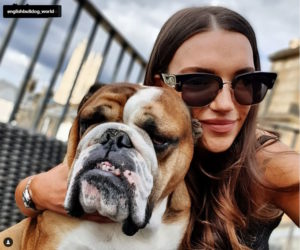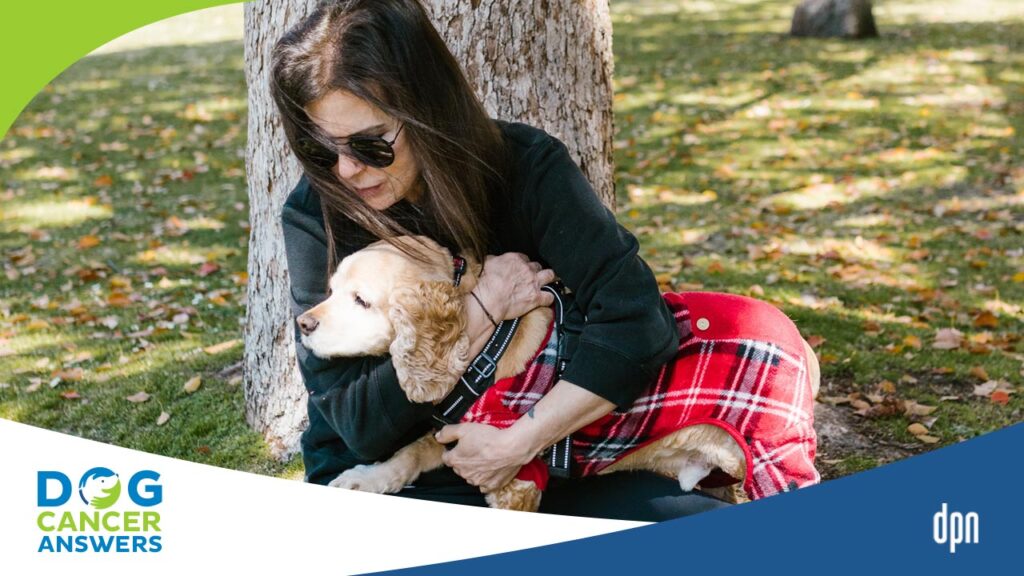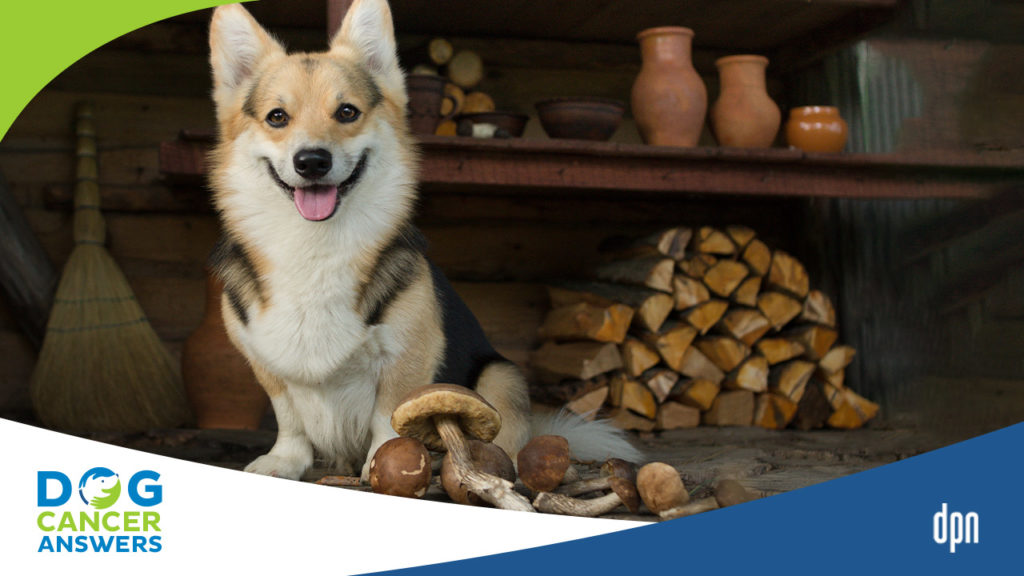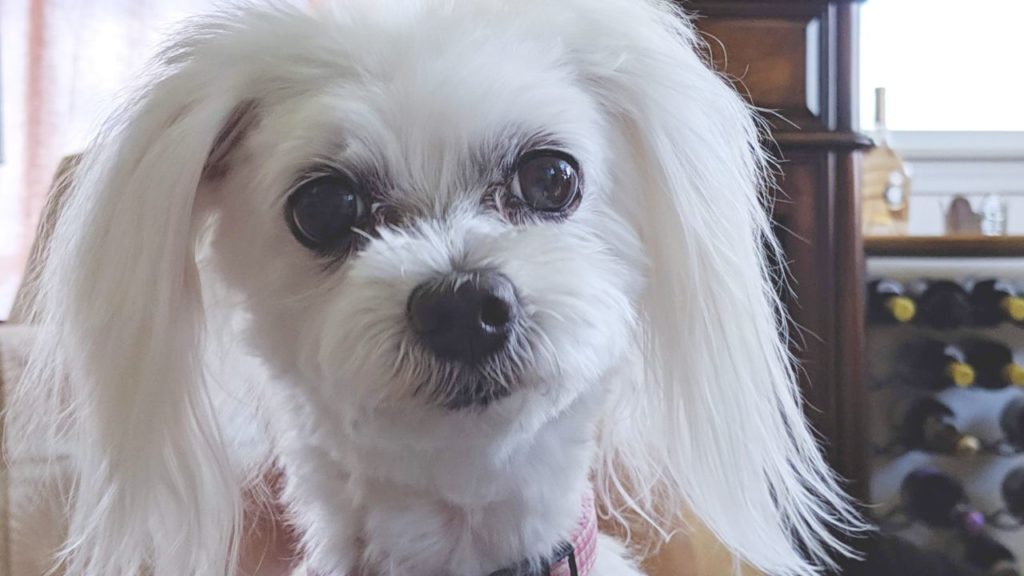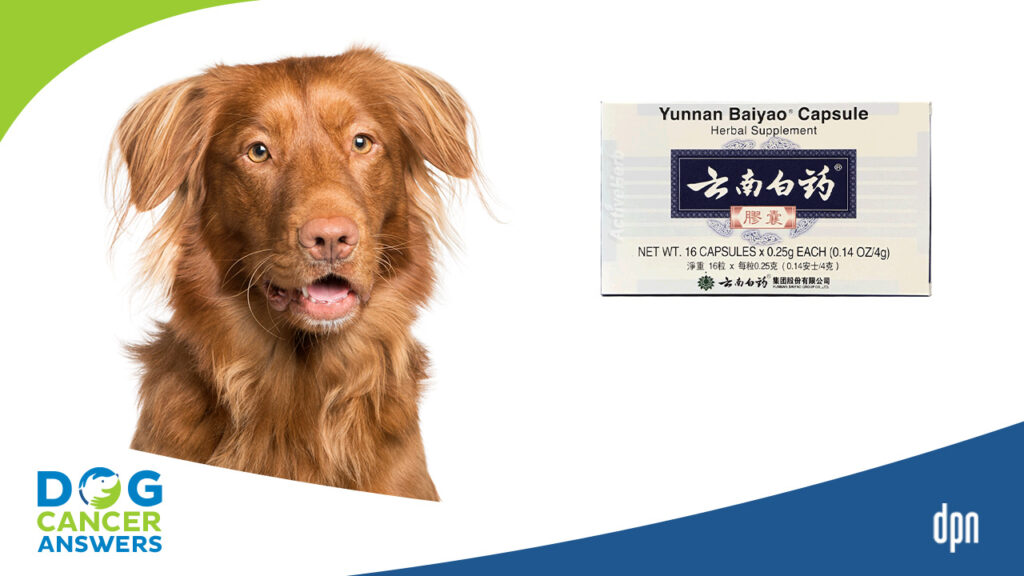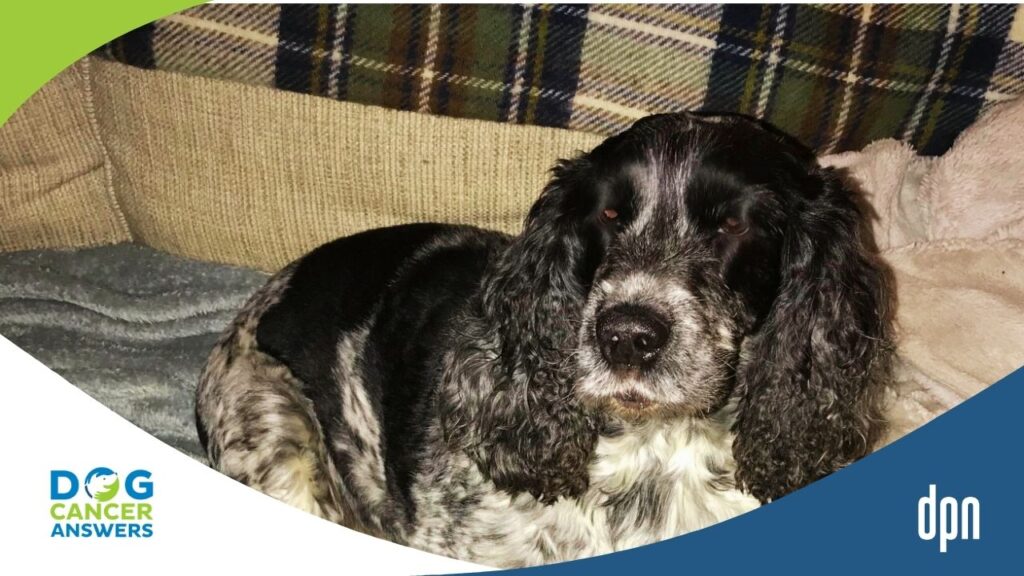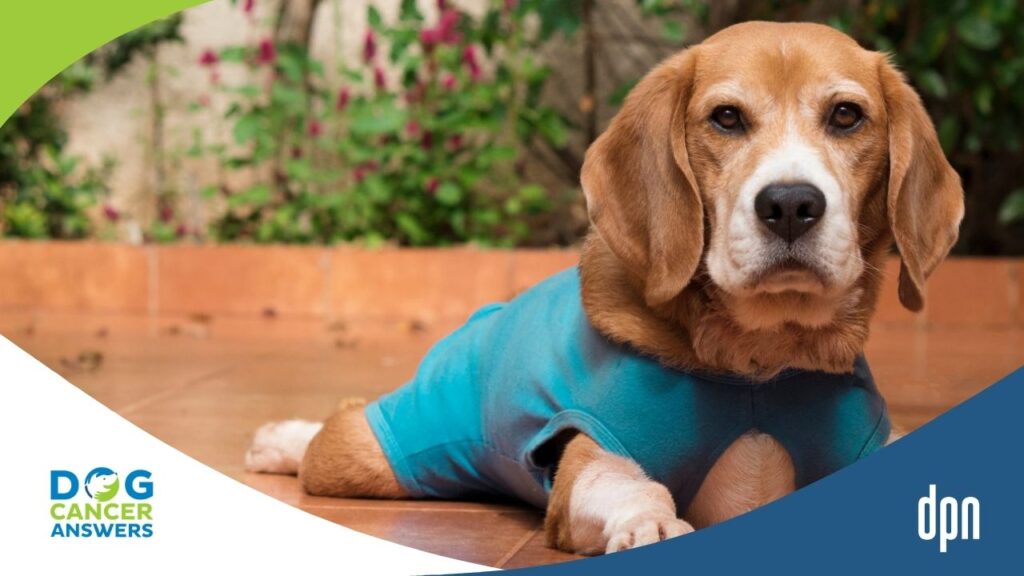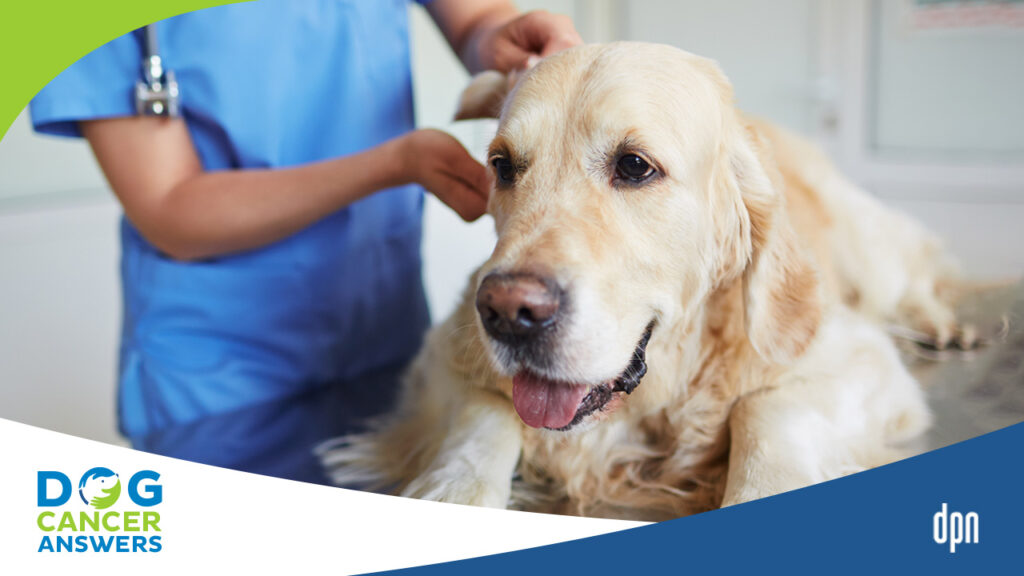EPISODE 201 | RELEASED January 30, 2023
Dog Cancer True Tail: Buddy Beats Hemangiosarcoma | Laura Gillespie
Buddy the Bulldog is a dog cancer success story, and against the formidable foe hemangiosarcoma no less!
SHOW NOTES
When Buddy was diagnosed with hemangiosarcoma, Laura and Richard were devastated. Even worse, he did very poorly after his first chemo treatment. With chemotherapy now off the table, they changed tactics and focused on general well-being and quality of life. A year and a half later, Buddy is still thriving!
Listen in to hear the full story, along with a discussion of median survival times and how you can approach your dog’s cancer journey one step at a time.
[00:00:00] >> Laura Gillespie: Now, I’ll cook him the veg, but I just buy the cooked chicken. Sometimes like a whole rotisserie chicken, and then just break it up and give it to him. But no, I don’t know if, because I don’t eat meat, so I don’t know if it’s because I, I didn’t know how to cook the chicken properly or something.
[00:00:17] >> Announcer: Welcome to Dog Cancer Answers, where we help you help your dog with cancer.
[00:00:24] >> Molly Jacobson: Hello, friend. Today on Dog Cancer Answers, we’re here with one of our favorite features, a True Tail. This is the True Tail of Buddy the English Bulldog, who was diagnosed with hemangiosarcoma in May of 2021 and is still here with us in early 2023. His owner, Laura, is joining us to share Buddy’s story, what treatments they tried, and how he’s doing today.
Laura Gillespie, thank you so much for joining us today to talk about Buddy and his amazing True Tail. His survival story as you called it when you first contacted us about Buddy.
[00:01:01] >> Laura Gillespie: Yeah. Pleasure.
[00:01:02] >> Molly Jacobson: So Laura, tell me a little bit about Buddy.
[00:01:07] >> Laura Gillespie: Buddy is a smooshy faced English Bulldog. Um, he is six going on seven. He is absolutely wild. He actually has two personalities. There is the Buddy who lies on the couch and you can’t get him up. You could never get him off the couch if he doesn’t wanna move. That same Buddy would lie in bed until one o’clock in the afternoon if you didn’t get him up and drag him out, say like, he’s too busy.
[00:01:37] >> Molly Jacobson: Even if he has to pee.
[00:01:38] >> Laura Gillespie: Oh no.
[00:01:38] >> Molly Jacobson: He’s like, I’m not getting up to pee.
[00:01:39] >> Laura Gillespie: I’m like, I wonder sometimes if I didn’t make you move, would you hold it in all day? Like, I think, and if he just, he’s so lazy. Then there’s the other side of Buddy who is absolutely wild. If someone comes into the house, he is running to his, his toy collection bringing you all his toys, he’s jumping up on people, knocking them over ’cause he’s so heavy. Um, he’s grunting around the, around the house chasing – I have another dog – yeah. So Buddy is crazy and lazy at the same time.
[00:02:11] >> Molly Jacobson: Crazy and lazy. Oh.
[00:02:13] >> Laura Gillespie: And very cuddly. He’s so cuddly.
[00:02:16] >> Molly Jacobson: Aw, that is so nice. That is so nice when a dog is cuddly.
[00:02:20] >> Laura Gillespie: Oh, it’s great.
[00:02:21] >> Molly Jacobson: Doesn’t it just make you feel like the most special person in the world?
[00:02:24] >> Laura Gillespie: Yeah. Sometimes he doesn’t come to you voluntarily for a cuddle. Like he’ll make sit at the end of the couch. But I do this thing where I like, I flip him and then he’ll just give in. So you flip, as he’s sitting on the edge of the couch, like I’ll sweep my hands under and flip him backwards so that he’s lying on top of me with his legs in the air and he’ll just start to snore, with all four legs in the air and he just gives in.
Oh, it’s so funny. And he loves it.
Yeah. He’s so cuddly.
[00:02:51] >> Molly Jacobson: Aw. He sounds like just a wonderful dog-
[00:02:55] >> Laura Gillespie: Yeah.
[00:02:55] >> Molly Jacobson: -with that distinct personality. All dogs really are their own person, right?
[00:03:00] >> Laura Gillespie: Yeah.
[00:03:01] >> Molly Jacobson: So when did you first notice that something was going on with Buddy?
[00:03:04] >> Laura Gillespie: So it was beginning of April, 2021. Um, Buddy, he was acting strange. He was kind of unwell on and off. We’d taken him to the vet a couple of times ’cause he wouldn’t eat anything. And then, you know, we’d just found him like lying in strange places. Like he’d go into the bathroom, into the corner of the bathroom and, and like sleep in there in the middle of the day when you couldn’t find him and it just was really abnormal for him.
So, uh, we’d taken him to the vet maybe like two times, and by the time we got to the vet he was like bounding in there and he was fine, like back to health and they were like, yeah, he’s fine. There was nothing wrong with him.
[00:03:43] >> Molly Jacobson: Oh my goodness.
[00:03:44] >> Laura Gillespie: Yeah, it was so strange. And it happened a couple of times and then we took him to the vet when it was really bad, he wouldn’t eat for a couple of days. And I noticed that his gums were like kind of not pink.
[00:03:55] >> Molly Jacobson: Oh.
[00:03:55] >> Laura Gillespie: He was just lying at the front door. He was acting really strange. So when we took him to the vet, they were like, the only option really is to do like an abdominal scan, and when we did that, they found a mass on his spleen and they had tested it. So we had a week to wait. This was like in May, 2021. And they tested it, and then they came back, they said it was the hemangiosarcoma. And we then did all of our research and, and realized, you know, this is really not good.
And the prognosis they gave us, they said one to three months without chemo, or with chemo up to kind of nine, 10 months.
[00:04:32] >> Molly Jacobson: So I just wanted to ask, his gums were pale when you first brought him in, but they didn’t suspect an internal bleed?
[00:04:39] >> Laura Gillespie: That’s why they did the abdominal scan.
[00:04:42] >> Molly Jacobson: That’s why they did the abdominal scan.
[00:04:44] >> Laura Gillespie: Yes.
[00:04:44] >> Molly Jacobson: Okay. So his gums were pale.
[00:04:46] >> Laura Gillespie: Yeah.
[00:04:47] >> Molly Jacobson: Which prompted an abdominal scan.
[00:04:49] >> Laura Gillespie: Yeah.
[00:04:49] >> Molly Jacobson: And then they found a mass on the spleen, but they didn’t remove it at that time. They did it, it wasn’t-
[00:04:55] >> Laura Gillespie: No, they did. Sorry. They did that. They removed it right away.
[00:04:57] >> Molly Jacobson: Oh, okay.
[00:04:57] >> Laura Gillespie: They removed the spleen and they tested the spleen at that point to see if it was like a cancerous tumor or not.
[00:05:04] >> Molly Jacobson: Okay.
[00:05:05] >> Laura Gillespie: And then we got the results after that to see that that’s what it was. So yeah, we decided to give him chemo. We were like, yeah, we could give him some extra time, let’s give it a try. He had one dose of chemo and he was so unwell. He, it was, it was awful. He ended up going back into the vet hospital for three days after his chemo to get fluids and he stayed there for three whole days. It was such a shame and that, we thought we were gonna lose him at that point because the chemo, he took such a bad reaction to the chemo.
So we decided, obviously then, he came out of that fine and we decided not to continue with the chemo. We were just gonna have to accept that he had one to three months and be healthy rather than put him through that again. So yeah, that’s where we were. And Richard, my partner, he had been, he likes to research everything like so deeply. He went online and he finds this other dog on YouTube. She had the same cancer, was given a couple of months to live, and she was pregnant with puppies.
[00:06:09] >> Molly Jacobson: Oh no.
[00:06:10] >> Laura Gillespie: I know, awful. So awful. But she, they gave her this special diet, they gave her medicinal mushrooms. It’s like a keto diet, you know, like people with cancer and stuff swear by keto diets to shrink tumors. So this dog on YouTube, she had all these tumors and they gave her this diet and these mushrooms and she lived a healthy, happy life. She gave birth to all these puppies, they were all healthy.
Like so we saw that and we’re like, right, that’s what we’re doing. We’re not doing chemo. We’re gonna swap to this diet. And we have been so strict with this diet ever since, in what, we’re 2023 now and Buddy’s still crazy for life.
[00:06:49] >> Molly Jacobson: Buddy’s still with you.
[00:06:50] >> Laura Gillespie: Yeah.
[00:06:51] >> Molly Jacobson: That’s amazing. So I’ve never been able to get anybody to fully explain to me how a keto diet is different than the general dietary guidelines that Dr. Dressler, for example, recommends. Other than usually people don’t wanna do any grains at all.
[00:07:08] >> Laura Gillespie: Yeah.
[00:07:08] >> Molly Jacobson: Dr. Dressler says you can use brown rice and steel cut oatmeal ’cause they have cancer fighting properties, and that slow release of carbs doesn’t spike blood sugar. But there are some people who do keto who say, oh no, you can’t do that. And then there’s other like vegetables that they use, but sometimes it’s raw and sometimes it’s not. So when you say you used a keto diet, what is the diet that you have been really strict with Buddy about?
[00:07:35] >> Laura Gillespie: He gets no carbs. Um, even down to the, the vegetables that we use, like low carb veg, like you know what I’m talking about, proper diet, but like, you know, they say some carrots and corn can digest into simple sugars, so like even I don’t give him them. He gets broccoli, spinach, parsley, cauliflower, and then just meat. Like chicken, sometimes mince, like high fat mince. And then lots of oil, so like coconut oil, he gets cottage cheese. What else do I give him? Garlic, ginger. Yeah, he gets all the goodness.
[00:08:13] >> Molly Jacobson: Okay.
[00:08:14] >> Laura Gillespie: So like high fat, protein.
[00:08:15] >> Molly Jacobson: So it sounds like Dr. Dressler’s diet without the oatmeal and the-
[00:08:20] >> Laura Gillespie: Yeah.
[00:08:20] >> Molly Jacobson: Okay. And the brown rice. All right.
[00:08:22] >> Laura Gillespie: Sometimes I’ll give him brown rice. We kind of try to not give him brown rice, but sometimes I do give him that. I think that the diet that we’re following, that this, that other dog on YouTube had, they do get brown rice.
[00:08:33] >> Molly Jacobson: Mm-hmm.
[00:08:33] >> Laura Gillespie: I think they must need some sort of, of fiber. So like depending on how his stomach is, like when he goes to the toilet and stuff like that, I might then add in the brown rice. But he does well on this diet and he eats it up. He loves it. He gets so, so much veg, so much protein. And it must be working, I guess.
[00:08:52] >> Molly Jacobson: Yeah. So what else have you done besides this diet?
[00:08:56] >> Laura Gillespie: That’s generally it. And the mushroom, adding in these mushroom drops.
[00:09:00] >> Molly Jacobson: Uh huh.
[00:09:00] >> Laura Gillespie: So he gets his mushroom drops twice a day, and that’s it.
[00:09:03] >> Molly Jacobson: That’s it.
[00:09:04] >> Laura Gillespie: Also, I think as well, at Christmas last year, so a year ago, um, Richard got me a puppy for Christmas. At this point, you know, that was the year that Buddy had been unwell in the May and we were already way past how long we thought he was gonna live. And he still was really happy and healthy, and he bought me this puppy and I was at first nervous ’cause I’m like, oh is this gonna work out? ‘Cause you know, Buddy’s not been well, and this and that, but he was happy and healthy.
[00:09:31] >> Molly Jacobson: He was given one to three months, six months ago. Do we really wanna introduce a new stressor into his life right now?
[00:09:38] >> Laura Gillespie: Yeah. And make him unhappy in, in his space, ’cause Bulldogs, they, I think they don’t really love to share the attention, that they, they, a lot of them like to be the only dog. So that really worried me bringing another dog into the mix. But I think she has had such an influence on him being full of energy. Like the two of them run around crazy all day long.
They’re best friends. They sleep together, he kisses her feet. I mean, they’re so cute. They’re so cute.
[00:10:07] >> Molly Jacobson: What’s your puppy’s name?
[00:10:08] >> Laura Gillespie: Lady.
[00:10:10] >> Molly Jacobson: Lady. What kind of dog?
[00:10:11] >> Laura Gillespie: She’s a Dachshund. A wee sausage dog.
[00:10:14] >> Molly Jacobson: Oh!
[00:10:15] >> Laura Gillespie: I mean, they look hilarious together because Buddy is huge and she not.
[00:10:21] >> Molly Jacobson: Right. It’s a Bulldog and a Dachshund. That’s good.
[00:10:24] >> Laura Gillespie: Yeah. They’re such an unusual little duo but they get on really well, and they play well. It was very nerve wracking at the beginning ’cause he weighs about 30 kilos and she was tiny as a puppy, like he’s gonna break her. But, um, no, they’re good. And I, I genuinely think that’s had a huge impact on his health as well ’cause it’s kept him, he used to just lie about the house rather than ever – he’d go on walks there and again, but he’s quite lazy by nature. So she’s given him this new lease on life. He’s always yeah, running around. It’s good.
[00:10:58] >> Molly Jacobson: Oh, that is amazing. So we’re recording this in January of 2023, Buddy was diagnosed in May of 2021, Lady came into his life, in, at Christmas 2021.
[00:11:11] >> Laura Gillespie: Yeah.
[00:11:11] >> Molly Jacobson: So they’ve had just over a year together, and you think he’s really thriving on the keto diet, the mushroom drops, and Lady’s love.
[00:11:21] >> Laura Gillespie: I think so. That or just, uh, an all-round miracle of some sort. We never thought he would even see Christmas last year. And then he turned six in April, and then he’ll be seven in four months.
[00:11:35] >> Molly Jacobson: In just a few months.
[00:11:36] >> Laura Gillespie: Yeah. And that, he was diagnosed just like after his fifth birthday.
[00:11:42] >> Molly Jacobson: Ugh.
[00:11:42] >> Laura Gillespie: And we never ever thought that we would get like this, this far, so.
[00:11:46] >> Molly Jacobson: That much time.
[00:11:47] >> Laura Gillespie: Mm-hmm. And he still, he’s crazy. And see when he was unwell, we could tell after the chemo and stuff that he, when he wouldn’t eat – ’cause Buddy loves food, that’s when you can kind of tell that he’s not well, when he won’t eat his food. But he is like so quick at eating his dinner, he’s got such a good appetite, loves to run around. So yeah, I think he’s still doing really well.
[00:12:11] >> Molly Jacobson: Have you had follow up scans to take a look and see if there’s anything still there?
[00:12:16] >> Laura Gillespie: We did the first year, so, so we diagnosed in May, we had our first scan in the September. After we’d stopped the chemo, we were like, right, let’s check and see what’s going on. And there was no tumors for him, there was nothing there. And the vets were like, wow. And then we had another one again that year in the November. Same thing. He was all clear.
Since then, we haven’t had another. We just decided not to for a couple of reasons, really. When he goes in for his scans, he has to be sedated. It takes him a few days to come around after, and it seemed, I just felt really bad for him every time we did that to him because he was so tired. He was out of it for a couple of days, didn’t eat properly, and stuff. And if they were to find something, we’re not gonna put him through chemo again.
So we kind of made the decision just to see how he goes and like he has been doing so well. So we haven’t felt the need to do that. So yeah, we’re just taking each day. We’ll see how he goes, but I don’t think, we’ll, we’ll do that again.
[00:13:19] >> Molly Jacobson: It sounds like Buddy doesn’t do well on drugs in general, ’cause he’s even having a hard time with the anesthesia-
[00:13:26] >> Laura Gillespie: Yeah.
[00:13:26] >> Molly Jacobson: -for an ultrasound, which is not a general anesthesia, it’s just a light anesthesia. So I would think that it’s wise to kinda back off on, on those pharmaceuticals for him and-
[00:13:38] >> Laura Gillespie: Yeah.
[00:13:38] >> Molly Jacobson: It sounds like the first surgery took out the primary tumor and it, at least till now, just hasn’t metastasized. So you guys have a cancer free dog at the moment.
[00:13:49] >> Laura Gillespie: Yeah. Absolutely delight.
[00:13:50] >> Molly Jacobson: This is wonderful.
[00:13:52] >> Laura Gillespie: We learned a lot about the, hemangiosarcoma obviously is in the blood cells. So they say it’s a matter of time before the tumors start to form and saying, so basically we’re like, all we can do is just be really strict with this diet, make sure he doesn’t get any carbs, don’t give – ’cause we saw that something online that said that cancer and tumors feed on carbs.
[00:14:12] >> Molly Jacobson: Some do.
[00:14:13] >> Laura Gillespie: So just avoid that as much as we can. Give him the best food, all the superfoods, the mushroom drops that are clearly working, and just keep going with that and he seems to be happy and healthy.
[00:14:27] >> Molly Jacobson: And just giving him a great quality of life. What else do you guys do for Buddy’s quality of life?
[00:14:32] >> Laura Gillespie: So he has, obviously he loves little Lady, but um, Richard’s parents have three dogs. We’re staying with them just now actually. There’s five dogs in the house and they are his best friends.
[00:14:46] >> Molly Jacobson: That’s officially a pack.
[00:14:49] >> Laura Gillespie: Yeah, they’re so funny together. He just runs into the house. When, when we weren’t staying here, we would bring Buddy and Lady around here if we had like a day out or something and it was like his happy place. So we’d be like, I think Buddy’s not been to see Granny for a while, let’s take him around to Granny’s house. And that’s just his happy place.
[00:15:05] >> Molly Jacobson: Aww.
[00:15:06] >> Laura Gillespie: He likes a wee walk now and again, but, um, you kinda have to drag Buddy to the park, to be honest. But when you get him there, he, he enjoys it.
[00:15:15] >> Molly Jacobson: Oh, once he’s at the park, he’s fine. He just doesn’t like the journey.
[00:15:17] >> Laura Gillespie: Yeah. Once he’s at the park and take him off the lead, he’ll run around. He’s got, looks like he’s got a big smile on his face, he, he’s happy. Um, but to get him to the park, it’s so funny. You have to really drag him there. I don’t understand. I think it’s a Bulldog thing, they’re very stubborn. Very stubborn.
[00:15:33] >> Molly Jacobson: I’ve never had a Bulldog myself, but that is my understanding, is that they have their own ideas about the way the world should work.
[00:15:40] >> Laura Gillespie: Oh, 100%.
[00:15:41] >> Molly Jacobson: And they have the heft and the strength to enforce those ideas.
[00:15:45] >> Laura Gillespie: It’s so funny sometimes, like my neighbors used to laugh at me, and they see me trying to get Buddy to the park and I’m physically putting all of my might into, to drag this dog to the park. He’s so heavy.
[00:15:58] >> Molly Jacobson: Yeah. I’m glad you can master Buddy’s walks, but it sounds like it’s-
[00:16:02] >> Laura Gillespie: I’ve managed to get stronger, I think just from pulling him to the park. Also, I sometimes will take little treats in my pocket.
[00:16:11] >> Molly Jacobson: Oh yes.
[00:16:11] >> Laura Gillespie: And try and coax him to the parks, I am, by giving him some biscuit
[00:16:17] >> Molly Jacobson: Does that work?
[00:16:18] >> Laura Gillespie: Yeah, he’s quite greedy. He likes a biscuit.
[00:16:20] >> Molly Jacobson: Okay. Well that’s good. What do you give him for a biscuit?
[00:16:23] >> Laura Gillespie: Oh, so, um, we have these superfood treats. We get ’em from Costco.
[00:16:27] >> Molly Jacobson: Uh huh.
[00:16:28] >> Laura Gillespie: They’re like little disks. They have beet root and Omega3 and he loves them.
[00:16:34] >> Molly Jacobson: That’s great.
[00:16:35] >> Laura Gillespie: He really likes them. Um, beef, there’s beef ones, chicken ones, and they’re not like, kind of grainy dog food treat. So yeah, I’m even strict um, with the treats. All the goodness.
[00:16:46] >> Molly Jacobson: Do you cook for Buddy?
[00:16:47] >> Laura Gillespie: So I used to kind of batch cook him, I would make all the chicken and make all the veg. And then sometimes he would get a bit of an upset stomach. I don’t know if it was because I would put it in like a Tupperware dish and put it into the, the fridge, and then sometimes that didn’t really work for him.
So now I’ll cook him the veg, but I just buy the cooked chicken. Sometimes, like a whole rotisserie chicken, and then just break it up and give it to him.
[00:17:15] >> Molly Jacobson: Sure.
[00:17:16] >> Laura Gillespie: But no, I don’t know if, if, um, because I don’t eat meat, so I don’t know if it’s because I, I didn’t know how to cook the chicken properly or something. I don’t know, but a couple of times-
[00:17:26] >> Molly Jacobson: Leave that to the professionals.
[00:17:28] >> Laura Gillespie: Yeah. I thought I’ll just, I’ll just buy the meat. I’ll cook the veg. And that’ll do.
[00:17:33] >> Molly Jacobson: That’s wonderful. And I, most dogs like that rotisserie chicken.
[00:17:37] >> Laura Gillespie: Yeah.
[00:17:37] >> Molly Jacobson: Most humans do too, right? I mean, it’s delicious.
[00:17:40] >> Laura Gillespie: Oh, he goes crazy for that.
[00:17:42] >> Molly Jacobson: Yeah.
[00:17:43] >> Laura Gillespie: And I have to, as a non meat eater, I have to peel it off the bone and stuff. I’m like, I’m doing this for you, Buddy.
[00:17:50] >> Molly Jacobson: Right.
[00:17:51] >> Laura Gillespie: And he goes crazy for that chicken.
[00:17:54] >> Molly Jacobson: That’s so wonderful. Buddy is lucky to have you. You’re one of those people who take your dog guardianship very, very seriously and do a lot of work on all levels, right? Like it’s physical work, physically dragging him.
[00:18:10] >> Laura Gillespie: Yeah.
[00:18:10] >> Molly Jacobson: It’s, you know, overcoming your own, like not liking to handle meat, but you do it for Buddy, and look at the results that you’re getting.
[00:18:19] >> Laura Gillespie: Yeah.
[00:18:19] >> Molly Jacobson: A happy and healthy dog.
[00:18:21] >> Laura Gillespie: He’s worth it. He’s-
[00:18:22] >> Molly Jacobson: It’s really wonderful.
[00:18:23] >> Laura Gillespie: You’ve seen his face, haven’t you? He’s just an, I just give in to that face.
[00:18:26] >> Molly Jacobson: Yeah.
[00:18:26] >> Laura Gillespie: He’s so cute. I would do anything for that .
[00:18:29] >> Molly Jacobson: Hold that thought just for a moment while we take a quick break to listen to our sponsors and then we’ll be back with Buddy’s True Tail.
And we’re back with Laura Gillespie. You pay very close attention to your dogs and you really listen. Obviously they’re not speaking the English language, but they’re speaking to you, they’re communicating with you, and you’re listening. So what is your highest and best advice for those who are listening to us today about how to cope with their dog cancer journey, whether they’ve just been diagnosed or they’re somewhere farther along in the journey?
[00:19:06] >> Laura Gillespie: Yeah. I mean, I can only go by our experience ’cause we, it was a complete whirlwind. It was Buddy’s journey. But what really helped us, I would say, is just kind of research everything that you can. Maybe don’t rely on the prognosis. I’ve read so many stories about how dogs can super surpass the prognosis. And if you accept that that’s how long they’re gonna live, we tried everything with this diet and we thought, right, this is gonna work.
This is gonna work. And that was our positive ment, mental attitude. If we just thought, oh, he’s got one to three months to live and, and just accepted that, then I guess your dogs as well can sense your mood, if that makes sense. Like if you don’t have that positive attitude, they’ll pick up on that, like if you’re crying and upset and accepting that that’s it for them. So yeah, I guess stay positive, do your research, see everything you can. And from our situation, I would say look into diet as well. And mushroom.
[00:20:10] >> Molly Jacobson: Thank you so much for being with us today, Laura.
[00:20:14] >> Laura Gillespie: Pleasure.
[00:20:14] >> Molly Jacobson: And for telling us Buddy’s True Tail.
[00:20:17] >> Laura Gillespie: Thanks for having me.
[00:20:18] >> Molly Jacobson: What an amazing story Laura has about Buddy. Just to go over a couple of the fine points that her story touched on, I wanted to bring in our producer, Kate Basedow. Hi, Kate.
[00:20:31] >> Kate Basedow: Hi everyone.
[00:20:32] >> Molly Jacobson: Kate, as a licensed veterinary technician and the daughter of a veterinarian, you are deeply familiar with all the things that Laura and Buddy have gone through, along with Richard, Buddy’s dad. And I suppose Lady, Buddy’s puppy. One of the things that really pricked up my ears was her mention of if we just accepted the one to three months prognosis, then we would’ve been so sad and we wouldn’t have tried to do anything new or different and we wouldn’t have, have Buddy here with us.
I was thinking about how the number that veterinarians use when they give a prognosis is a median number, it’s the median survival time. It’s not an average number and it’s not a definite number. And so I thought it would be worth talking about that a little bit because Laura’s exactly right, you should not accept those numbers as the truth, because they’re not even intended to be the truth, right?
[00:21:29] >> Kate Basedow: Yeah. Because, the number that they give, that median survival time or the prognosis, is probably the most likely outcome, but you’re not guaranteed that, and you’re not guaranteed only that. 50% of the dogs will last less than that time, and about 50% will do better. Some only a little bit better, some dramatically better like Buddy did.
When you hear that number, you want to consider it and be realistic about the odds that your dog will be one of the exceptional ones that does spectacularly well for a long time, but you can also have that hope-
[00:22:09] >> Molly Jacobson: Right.
[00:22:09] >> Kate Basedow: -that your dog might be one of the ones who does better and gets at least that time, if not more.
[00:22:16] >> Molly Jacobson: And when you get the prognosis, at that time you don’t know which 50% your dog’s gonna be in. It is not known. It’s something that you will only know once that milestone has passed. And so, in my mind, at least for my peace of mind, the way my brain works, I take that and I set it aside as being like a mile marker on the road, like mile marker, one month, rather than dreading it. It’s just a signpost. It’s not something that means anything in and of itself.
It’s something to notice as it goes by and then to say, and now we don’t know how much longer this road lasts, but we can take from our dog’s signals, like Buddy is happy taking walks – somewhat reluctantly, but still walking – playing, eating, and otherwise healthy with no recurring on the scans, at least not so far. So we’re pretty happy with his prognosis because he has well passed that milestone of one to three months. He’s now well over a year and a half.
[00:23:23] >> Kate Basedow: Yeah.
[00:23:24] >> Molly Jacobson: And yes, he’s in the lucky, I call it the 50/50 day. The median survival time is their 50/50 mark, and he’s in the second 50, which is wonderful. But he could live a lot longer.
[00:23:35] >> Kate Basedow: Yeah.
[00:23:36] >> Molly Jacobson: ‘Cause nobody has a crystal ball that can tell you what’s going on with your dog.
[00:23:39] >> Kate Basedow: Yep. And the other thing that I really love about Buddy’s story is how they tried chemo because it could get you better odds and a better prognosis, but then when it didn’t work out for Buddy, they said, we’re not gonna keep doing this. ‘Cause that’s another one of those things where you never know how it’s gonna turn out until you try. And I think a lot of us tend to think that if we decide to pursue chemo, we are fully committed to that path and we’re stuck. And you’re not.
[00:24:09] >> Molly Jacobson: Right.
[00:24:09] >> Kate Basedow: If your dog is one of the unlucky ones like Buddy who doesn’t tolerate chemo well, whether it’s a particular drug that’s a problem and you want, and you end up switching protocols if there’s other options, or if you do like Laura and her partner did and drop chemo completely, you only know how your dog is going to handle chemotherapy if you try it. That doesn’t mean you have to try it with every dog and it, ’cause every case is different.
But listen, talk to your oncologist and your veterinarian about your dog’s condition and what the options are going forward, and know that if you do try chemo and your dog really doesn’t handle it well, you absolutely have the option to regroup and redirect and change tactics.
[00:24:54] >> Molly Jacobson: That’s right. Depending on how severe those side effects are – most dogs tolerate chemo really nicely.
[00:25:00] >> Kate Basedow: Yeah.
[00:25:00] >> Molly Jacobson: With manageable side effects, if they have any at all. The goal that a veterinary oncologist has is not to have side effects.
[00:25:07] >> Kate Basedow: Yeah. Vets don’t like seeing sick dogs.
[00:25:09] >> Molly Jacobson: No, no. No vet likes seeing sick dogs. And so if a dog doesn’t do well, they will adjust doses for the next round, or they will switch agents to something that they think the dog might tolerate better, or if the symptoms are really severe, they’ll say, we’re not gonna get any better results, so we’re gonna stop altogether. The vet oncologist is not fully committed to chemo either.
[00:25:36] >> Kate Basedow: Yeah.
[00:25:36] >> Molly Jacobson: They don’t go in thinking we’re gonna do 19 rounds of chemo, or we’re gonna do six rounds of chemo. This is all trial and error because every single dog and every single cancer case is different. There’s no one size fits all treatment. So your point is well taken that if we can afford and are comfortable with trying chemo, we should go ahead and try it. If the numbers are what we want, right? Like all of those things are, are your own personal decisions to weigh. Are the odds good enough, am I gonna get enough time, do I have the budget for this, do I have the financial budget, do I have the emotional budget, what kind of aftercare will I need, can I deal with side effects if they arise, all of them. Personalities, issues that people have, like sometimes people just really don’t want it, from their own experience or watching another human loved one.
I’ve had dogs I would never put on chemo just ’cause I know that they would not be happy going to the vet that often. And then I have other dogs where, yeah, sure I would’ve because they would’ve been fine, they like going to the vet and they wouldn’t have associated any side effects with the vet.
[00:26:43] >> Kate Basedow: Yeah.
[00:26:43] >> Molly Jacobson: They would’ve had those happen later at home. It would’ve been okay with them. So you gotta make your choice based on, at this moment, what do you think is best, and then know that you can make a new choice later. And that is okay, and not only okay, but expected. It’s part of the cancer journey.
[00:27:01] >> Kate Basedow: Absolutely.
[00:27:03] >> Molly Jacobson: This is just such a really, really special story, and I love that Laura and Richard are so, so in love with Buddy, and they take such excellent care of him. Clearly he’s thriving on that keto diet that has very, very few or no grains whatsoever. Some dogs do really well on that kind of diet anecdotally, from what I’ve seen. My dogs never did well on a diet without grains when they had cancer, they just had no energy. They needed that extra calories and those healthy carbs.
So that’s a whole can of worms that we will be talking about a lot over the coming years, all these different dietary plans and patterns. And again, I’ll just say here, Kate, I’m gonna just go with, what’s right for one dog might not be right for another dog, and there is no one size fits all.
[00:27:52] >> Kate Basedow: Absolutely. And it’s totally okay in pretty much every aspect of your cancer journey with your dog, if the first thing you try doesn’t work out well, it’s okay to regroup and try something else. Medicine and biology are not perfect exact sciences, and every individual has individual different factors that come into play. And so a lot of the time the best plan for one dog that’s gonna be a miracle cure isn’t gonna work at all for another dog. So it’s okay to adjust and make changes.
[00:28:28] >> Molly Jacobson: Absolutely. 100%. And I think that is so beautifully illustrated by Laura’s True Tail about Buddy because even the change of bringing in a new puppy into the house, she tried it and it worked. And, uh, she trusted her gut. And I think that’s the bottom line is that you know your dog and you know yourself and you know what you can handle and what they can handle. So trust your gut when it comes to cancer, just like any other part of being a dog parent.
[00:28:57] >> Kate Basedow: Yep. Get all the information, talk to your vet, and then trust what you feel is best.
[00:29:02] >> Molly Jacobson: Right. And know you can make a new choice if you need to, that you’ll be adjusting and adjusting and adjusting.
[00:29:08] >> Kate Basedow: Mm-hmm.
[00:29:09] >> Molly Jacobson: And that’s, that’s just the way it is.
Well, thank you, listener. If you have a True Tail you wanna share with our listeners, please let us know. You can send us an email or you can call our Listener Line (808) 868-3200 and tell us your True Tail and we’ll get in touch and see if it makes a good show so that other people can learn from your wonderful experience with your beloved dog on your cancer journey. I also wanna remind you that Dog Cancer Support group is here for you. We’re on Facebook.
You can search for Dog Cancer Support, or you can go to dogcancer.com and follow the link there to get to our Facebook group, Dog Cancer Support. Lots and lots of Laura Gillespies there, all ready and willing to help you think through things, give you their own True Tails, and help you to cope with dog cancer. ‘Cause it is an emotional journey.
Thank you so much for listening, listener. I’m Molly Jacobson and here with Kate Basedow, from all of us here at Dog Podcast Network, are wishing you and your dog a very warm, Aloha.
[00:30:23] >> Announcer: Thank you for listening to Dog Cancer Answers. If you’d like to connect, please visit our website at dogcanceranswers.com or call our Listener Line at (808) 868-3200. And here’s a friendly reminder that you probably already know: this podcast is provided for informational and educational purposes only. It’s not meant to take the place of the advice you receive from your dog’s veterinarian.
Only veterinarians who examine your dog can give you veterinary advice or diagnose your dog’s medical condition. Your reliance on the information you hear on this podcast is solely at your own risk. If your dog has a specific health problem, contact your veterinarian. Also, please keep in mind that veterinary information can change rapidly, therefore, some information may be out of date.
Dog Cancer Answers is a presentation of Maui Media in association with Dog Podcast Network.
Hosted By
SUBSCRIBE ON YOUR FAVORITE PLATFORM
Topics
Editor's Picks
CATEGORY
